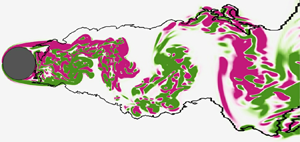Crossref Citations
This article has been cited by the following publications. This list is generated based on data provided by
Crossref.
Kou, Jiaqing
and
Zhang, Weiwei
2021.
Data-driven modeling for unsteady aerodynamics and aeroelasticity.
Progress in Aerospace Sciences,
Vol. 125,
Issue. ,
p.
100725.
Rocha Ribeiro, Bernardo Luiz
and
Franck, Jennifer A.
2021.
A Machine Learning Approach to Classify Kinematics and Vortex Wake Modes of Oscillating Foils.
Xiao, Qianhao
Shi, Xuna
Wu, Linghui
Wang, Jun
Ding, Yanyan
and
Jiang, Boyan
2021.
Squirrel-Cage Fan System Optimization and Flow Field Prediction Using Parallel Filling Criterion and Surrogate Model.
Processes,
Vol. 9,
Issue. 9,
p.
1620.
Fang, L.
Bao, T.W.
Xu, W.Q.
Zhou, Z.D.
Du, J.L.
and
Jin, Y.
2022.
Data driven turbulence modeling in turbomachinery — An applicability study.
Computers & Fluids,
Vol. 238,
Issue. ,
p.
105354.
Zhan, Qing-Liang
Bai, Chun-Jin
and
Ge, Yao-Jun
2022.
Deep learning representation of flow time history for complex flow field.
Acta Physica Sinica,
Vol. 71,
Issue. 22,
p.
224701.
Qiu, Chengcheng
Huang, Qiaogao
and
Pan, Guang
2022.
Prediction of Cavitation Performance over the Pump-Jet Propulsor Using Computational Fluid Dynamics and Hybrid Deep Learning Method.
Journal of Marine Science and Engineering,
Vol. 10,
Issue. 7,
p.
918.
Sahebjam, Rana
Kohan, Khashayar F.
and
Gaskin, Susan
2022.
The dynamics of an axisymmetric turbulent jet in ambient turbulence interpreted from the passive scalar field statistics.
Physics of Fluids,
Vol. 34,
Issue. 1,
Sofos, Filippos
Stavrogiannis, Christos
Exarchou-Kouveli, Kalliopi K.
Akabua, Daniel
Charilas, George
and
Karakasidis, Theodoros E.
2022.
Current Trends in Fluid Research in the Era of Artificial Intelligence: A Review.
Fluids,
Vol. 7,
Issue. 3,
p.
116.
Brown, Justin
Zimny, Jacqueline
and
Radko, Timour
2022.
Identifying the Origin of Turbulence Using Convolutional Neural Networks.
Fluids,
Vol. 7,
Issue. 7,
p.
239.
Qiu, Rundi
Huang, Renfang
Xiao, Yao
Wang, Jingzhu
Zhang, Zhen
Yue, Jieshun
Zeng, Zhong
and
Wang, Yiwei
2022.
Physics-informed neural networks for phase-field method in two-phase flow.
Physics of Fluids,
Vol. 34,
Issue. 5,
Qiu, Chengcheng
Huang, Qiaogao
Pan, Guang
and
He, Xing
2022.
Multi-path deep learning framework on discrete pressure points to predict velocity field of pump-jet propulsor.
Applied Ocean Research,
Vol. 123,
Issue. ,
p.
103173.
Davydzenka, Tsimur
and
Tahmasebi, Pejman
2022.
High-resolution fluid–particle interactions: a machine learning approach.
Journal of Fluid Mechanics,
Vol. 938,
Issue. ,
Zhou, Zhideng
Li, Binglin
Yang, Xiaolei
and
Yang, Zixuan
2022.
A robust super-resolution reconstruction model of turbulent flow data based on deep learning.
Computers & Fluids,
Vol. 239,
Issue. ,
p.
105382.
Price, Theron J.
Gragston, Mark
and
Kreth, Phillip A.
2022.
Analysis of Screech Phenomena in a Mach 1.0 Jet with Linear Array Focused Laser Differential Interferometry.
Xiao, Li
Qi, Xueyuan
and
Li, Fengquan
2022.
Non-Uniform Dependence on Initial Data for the Rotation-Camassa–Holm Equation.
Journal of Mathematical Fluid Mechanics,
Vol. 24,
Issue. 4,
Li, Jinlu
Yu, Yanghai
and
Zhu, Weipeng
2022.
Ill-posedness for the Camassa-Holm and related equations in Besov spaces.
Journal of Differential Equations,
Vol. 306,
Issue. ,
p.
403.
2023.
Study of interscale interactions for turbulence over the obstacle arrays from a machine learning perspective.
Physics of Fluids,
Vol. 35,
Issue. 4,
Ribeiro, Bernardo Luiz R.
and
Franck, Jennifer A.
2023.
Machine Learning to Classify Vortex Wakes of Energy Harvesting Oscillating Foils.
AIAA Journal,
Vol. 61,
Issue. 3,
p.
1281.
Whittaker, Tim
Janik, Romuald A.
and
Oz, Yaron
2023.
Neural network complexity of chaos and turbulence.
The European Physical Journal E,
Vol. 46,
Issue. 7,
Quilodrán-Casas, César
and
Arcucci, Rossella
2023.
A data-driven adversarial machine learning for 3D surrogates of unstructured computational fluid dynamic simulations.
Physica A: Statistical Mechanics and its Applications,
Vol. 615,
Issue. ,
p.
128564.

 $Re=100$ and 3900. Extreme gradient boosting (XGBoost) is utilized to train the detector, and after training, the detector is applied to identify the flow state at each point of the flow field. The trained detector is found robust in various tests, including the applications to the entire fields at successive snapshots and at a higher Reynolds number
$Re=100$ and 3900. Extreme gradient boosting (XGBoost) is utilized to train the detector, and after training, the detector is applied to identify the flow state at each point of the flow field. The trained detector is found robust in various tests, including the applications to the entire fields at successive snapshots and at a higher Reynolds number  $Re=5000$. The objectivity of the detector is verified by changing the input features and the flow region for choosing the turbulent training samples. Compared with the conventional methods, the proposed method based on machine learning shows its novelty in two aspects. First, no threshold value needs to be specified explicitly by the users. Second, machine learning can treat multiple input variables, which reflect different properties of turbulent flows, including the unsteadiness, vortex stretching and three-dimensionality. Owing to these advantages, XGBoost generates a detector that is more robust than those obtained from conventional methods.
$Re=5000$. The objectivity of the detector is verified by changing the input features and the flow region for choosing the turbulent training samples. Compared with the conventional methods, the proposed method based on machine learning shows its novelty in two aspects. First, no threshold value needs to be specified explicitly by the users. Second, machine learning can treat multiple input variables, which reflect different properties of turbulent flows, including the unsteadiness, vortex stretching and three-dimensionality. Owing to these advantages, XGBoost generates a detector that is more robust than those obtained from conventional methods.

